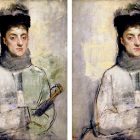The Case for Revolutionary Love

In both political and personal spheres, messages of “peace and love” or “love wins”—or even the now-popular “love is love is love is love”—can sometimes come across as empty platitudes. Yes, love wins in the movies, and we want to believe in its power, but such statements are often interpreted as presenting love, falsely, as a conclusion rather than a starting point. They, too, can fall into a cliché of positive psychology, and, worse, sometimes seem to make light of the lived experiences of suffering and oppression. But when a writer approaches the topic with the earnestness of a lifelong devotee and the fierceness of a skilled lawyer, a word as fraught as “love” can gather up its full gravity, its revolutionary potential. In See No Stranger: A Memoir and Manifesto of Revolutionary Love (2020), attorney and activist Valarie Kaur reframes the message of love so that it becomes the starting point, the guiding light, and the infinite wisdom-source for transformative action.
See No Stranger pushes a message of both personal and communal change through a radical love framework. Kaur’s book is deeply spiritual but does not push a particular conversion on its readers; instead, she urges us to apply her principles to our specific lives and communities, resisting the illusion of separateness and pushing for the kind of equality that comes with seeing every person as fully human in their inherent dignity. Notably, this message is echoed in two other popular nonfiction books from 2020—Love is the Way by Bishop Michael Curry, writing from the Christian wisdom tradition, and Radical Compassion by Tara Brach, writing from the Buddhist wisdom tradition. The movement for nonviolent change receives a special nod every year with the celebration of Dr. Martin Luther King Jr., but Kaur reminds us that the truth is that individuals and communities labor in this path every day and have been laboring in it for millennia, passing its lessons through wisdom traditions around the world.
In the 1988 essay “The Carrier Bag Theory of Fiction,” Ursula K. Le Guin suggests that the direction of progress for mankind, the story of our growing potential, should be thought of more as a vast collection or container rather than a “Techno-Heroic” arrow-style linear narrative. She tenderly describes early humans’ “hunter-gatherer” lifestyle as more truly oriented toward the gathering, and she constructs a feminist vision of human nature as more in tune with the earth than “Man vs. Nature” narratives would have us think. In See No Stranger, Valarie Kaur similarly envisions a nonlinear human story, where “transition” is an organic accumulation of love stories rather than a simple movement from one state of being to another. She writes, “Transition is an imperfect metaphor: There is no one point when a new society is born. We always find ourselves in the middle of a cycle.”
The phrase “revolutionary love” has been used in various contexts, but for Kaur, it stands for a spiritual, moral, and practical framework that transcends sentiment and is always in motion. She fans the spark of the word “love” so that it grows into an inspiring rallying cry for the ongoing revolution of radically love-centered praxis in the service of personal and interpersonal transformation and, more ambitiously but just as sincerely, large-scale communal redemption. She writes specifically of this vision for transforming the United States:
To promise the non-repetition of harm would require nothing less than transitioning the nation as a whole. It would mean retiring the old narrative about who we are—a city on a hill—and embracing a new narrative of an America longing to be born, a nation whose promise lies in the future, a nation we can only realize by doing the labor: reckoning with the past, reconciling with ourselves, restructuring our institutions, and letting those who have been most harmed be the ones to lead us through the transition.
It’s no small task. Thankfully, it’s already in motion, and the narrative of peaceful collective action has been passed down from each generation to the next. In Kaur’s version, developed over many years of work at the intersection of activism and law and grounded in the tradition of her Sikh faith, this framework of revolutionary love is not a list of rules—it’s a way of seeing and being and doing. She writes, “‘Revolutionary love’ is the choice to enter into wonder and labor for others, for our opponents and for ourselves in order to transform the world around us. It is not a formal code or prescription but an orientation to life that is personal and political and rooted in joy.” This drive toward active labor permeates the entire book. From everyday compassionate gestures to large-scale nonviolent demonstrations, Kaur points the way toward transformation and energizes the reader with her unfaltering hope.
For Kaur, the first step in this practice of revolutionary love is a way of seeing others with a sense of wonder: “Seeing no stranger begins in wonder. It is to look upon the face of anyone and choose to say: You are a part of me I do not yet know.” She introduces the tenet of “seeing no stranger” in the context of her Sikh faith; the phrase comes from the founder himself: “‘I see no stranger,’ said Guru Nanak, ‘I see no enemy.’ Guru Nanak taught that all of us could see the world this way.” Seeing another person with wonder opens up the potential for seeing them as fully human and ultimately seeing them as part of a mystical oneness in love, where the ego-centered notion of selfhood is just a temporary illusion.
While mysticism is certainly important to See No Stranger, perhaps the most impressive parts of the book are the straightforward arguments, the numerous examples, and the advice laying out the way of revolutionary love as a path that is not only sentimentally or morally good, but also a path that actually seems to work. Kaur is making the case for revolutionary love as a lawyer, too, and includes examples of times when conflicts felt insurmountable in her own personal and professional life. In the wake of hate crimes against Sikhs after 9/11 (especially against Sikh men who traditionally wear turbans), Kaur traveled the country mourning with families and communities and spreading awareness about the hatred perpetrated against Sikhs and Muslims in the United States. The perpetrators didn’t always have their hearts changed, but when they did, the impact was extraordinary. Perhaps more importantly, Kaur helped communities come together to cultivate love within mourning, always planting seeds of hope.
Loving one’s neighbor is tough when the neighbor is an outwardly violent racist, though Kaur doesn’t claim that it’s easy. Protection of the people being harmed should always come first, and sometimes self-love requires distance from the opponent; meanwhile, “self-love” itself can be helpfully reframed: “Perhaps it is time to shift the terms from ‘self-love’ to ‘loving ourselves.’ Loving ourselves happens in community.” Kaur reminds the reader that these principles of love can apply to all things. But for her, it’s not just about the principle of love, but also about the effectiveness of changing people’s hearts and minds by allowing them to feel truly seen. After embracing with care the complicated feelings involved in conflict resolution and harm-reduction work, she repeatedly circles back to the practical steps. Another example of a practical reframing technique is how Kaur suggests that we think about enemies as “opponents.” The true identity is in one’s personhood; the fact of being an opponent is temporary. To bring true presence to a situation, it’s important to see the other people as fully human, to “wonder” about them, to remember that they too have a whole inner life and life story. In addition to listening, then, storytelling is also essential to the practice of revolutionary love.
Kaur’s vision for change thus gathers up opponents into a story, refiguring them as members of the human family. Like Le Guin, Kaur’s storytelling itself embodies the radical nonviolence that forms part of the journey of revolutionary love. She treats every person as fully, complexly human, and this infectious way of seeing is the first step toward reconciliation after harm. Rather than pushing strict doctrines and linear visions of progress, See No Stranger presses into the reader’s hands a container stuffed full of deeply human narratives in which, at some level, revolutionary love really does work every time. The book, then, is not just a memoir and manifesto: it’s a carrier bag of love stories.
This piece was originally published on February 8, 2021.



